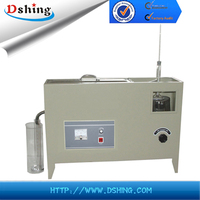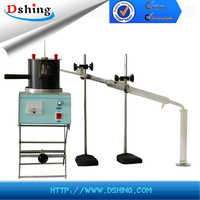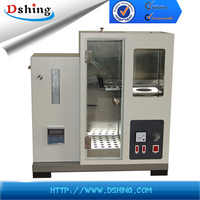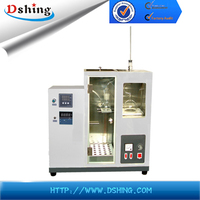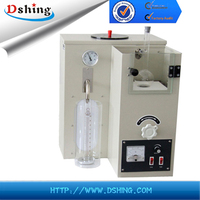DSHM-998F Photo-electric Direct Reading Spectrometer
Specifications
1. General
DSHM-998F type photo-electric direct reading spectrometer produced by our company is a rapid quantitative analytical instrument to analyze components of ferrous and nonferrous metals. This instrument is widely applied in metallurgy, machinery and other industrial sectors for on-line spot analysis before smelting furnace and product inspection in central lab and is one of effective means to control quality of products.
2. Features of instrument
2.1 Design of 750mm/1000 mm focus grating, Palmer type - runge device, high vacuum, high resolution and high sensitivity, etc. Due to higher-order spectrums produced by machine carved grating, route selection is more flexible so as to avoid interference of spectrums.
2.2 Structural design of the instrument is reasonable, electronic system adopts internationally standard chassis, and highly integrated circuit design enables low rate of faults.
2.3 Fast analysis speed, good repeatability and good stability.
2.4 Excitation light source with high stability is employed and excitation frequencies change within 150~500Hz, different excitation parameters can be chosen for analyzing different samples to reach the optimal analysis effect.
2.5 Highly integrated acquisition and control system is incorporated to exhibit high degree of automation.
2.6 Imported photomultiplier is adopted with features of small dark current, high signal-noise ratio and long service life, etc.
2.7 Analyzing and scanning process can scan all elements simultaneously, and simply scanning process can analyze deviation of each element from base elements quickly.
2.8 During excitation of samples water cooling is not required for excitation table, and continuous analysis of samples can also obtain good data.
2.9 Measurement and control system adopts measurement and control with single-board computer, which exchanges data with upper computer so as to improve operating speed.
2.10 Negative high voltage of photomultiplier in each channel is regulated via computer software at 8 grades so as to greatly improve utilization rate of channels and adoption of optimal linear scope of analytical spectral lines in analysis of different materials and reduce adopted quantity of channels and lower the cost.
2.11 The instrument can be used to analyze multiple bases: Fe, Co, Cu, Ni, Al, Pb, Mg, Zn and Sn, etc.
2.12 Operating software under all Chinese Windows system is employed, and operations are simply and easy to understand.
2.13 Database system is created for computer software with convenience for enquiry and print of measured data, and data can also be remotely transmitted via network conveniently and rapidly.
2.14 All systems are supplied independently and constitute units for convenient use and simple maintenance.
2.15 Adoption of constant temperature measure for optical parts guarantees normal operation of the instrument so as to reduce the requirements for environment.
2.16 High-precision linear motor is employed to carry out slit-in scanning at fast speed and high accuracy.
2.17 Integral emergence slit is adopted with convenience for addition of channels.
3. Technical indicators
3.1 Excitation light source:
1) Power supply voltage: 50Hz, 220V±10%
2) Input power: 1.0kVA
3) Charging capacitance: precombustion 7.5μF and exposure 1.5μF
4) Peak current: precombustion 120A and exposure 30A
5) Peak voltage of main circuit: 300VDC (automatic regulation of peak voltage is adopted)
6) Ignition circuit:
Pulse amplitude: +15kV
Auxiliary gap: tunnel diode is adopted
Discharging frequency: 150 Hz /500 Hz
3.2 Excitation table
1) Analysis clearance of sample table: 4mm
2) Argon filled sample holder without need of water cooling
3) Time interval of analysis: in general less than 60s
3.3 Spectrometer
1) Analysis band range: 160~800nm
2) Grating:
Radius of curvature: 750mm
Score density: 2400 lines/mm
Score area: 30×50mm2
Blaze wavelength (level 1): 300nm
Linear dispersion: 0.55nm/mm
3) Width of incidence slit: 20μm
4) Width of emergence slit: 50μm and 75μm
5) Photomultiplier: diameter 28mm, 10-grade side window tube, fused quartz or glass enclosure
6) Maximum permitted channels: 62
7) Local constant temperature of spectrometer: 35℃±0.1℃
3.4 Measurement and control system
1) Measurement and control system: single-board computer is adopted for measurement and control and exchanges data with upper computer.
2) Measuring method: segmental integral
3) Integral capacitance: 0.047μF
4) Repeatability: RSD≤0.2%
5) High-voltage power supply of photomultiplier
Voltage: -1000V
Stability: better than 0.5% within 8h
High voltage regulation: changes from -550V to -1000V and regulates at 8 (0-7) grades
High-voltage setup: changed by customers via computer software
3.5 Outline dimensions:
1) Host machine: 1520×1080×1080mm
2) Weight: approximate 550kg
- Country: China (Mainland)
- Business Type:
- Market:
- Founded Year:2013
- Address:
- Contact:Angel Chan


